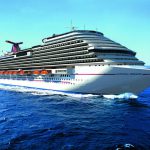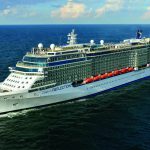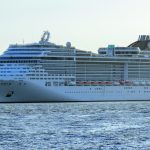Modern ocean-going cruise shipping basically started in the mid 1960s. First specialized tonnage was converted from Atlantic passenger liners which were commercially put in the shade after aircraft like Boeing 747 came into use.
Emergence of global cruise lines
In 1966, the Norwegian shipowner Knut Kloster (Klosters Rederi, Oslo) founded Norwegian Caribbean[ds_preview] Lines (NCL, later renamed in Norwegian Cruise Line) and started passenger shipping in the Caribbean from home port Miami. His co-founder at that time was Ted Arison who started his own company Carnival Cruise Lines (CCL) in 1972. Later, CCL received eight vessels of the »Fantasy«-class (70,367 GT) in 1990–1998 and four of the »Spirit«-class (88,500 GT) in 2001–2004 from Finnish yards. NCL began with a first newbuilding from a Norwegian yard and two cruise ships from a German yard. Thereafter, NCL ordered new and larger cruise ships from Finish, Italian and French yards. In 1968, Royal Caribbean Cruise Line (RCCL) was founded by Norwegian shipping companies Anders Wilhelmsen & Co., I.M. Skaugen & Co., and Gotaas Larsen. The newly created operator received its first ship, the »Song of Norway« (23,000 GT), in 1970 from Finnish Wärtsilä Helsinki Shipyard. One year later, the »Nordic Prince« (23,000 GT), also built in Finland, doubled the capacity. Continuing to expand, RCCL added »Sun Viking« (18,500 GT) in 1972.
After the merger with Celebrity Cruises in 1997, Royal Caribbean Cruise Line was re-branded Royal Caribbean International (RCI), whereas Royal Caribbean Cruises Ltd. (still RCCL) was formed as the parent company for both brands. Today, also Pullmantur Cruises, Azamara Club Cruises and CDF Croisières de France belong to RCCL.
Celebrity’s former main owner, Greek Chandris Cruises, had always been a good customer of German Meyer Werft. So, this new RCCL daughter company planned and finally received five highly sophisticated cruise ships of »Solstice«-class (122,000–126,000 GT) in the years 2008–2012. They became the forerunner of RCI’s »Project »Sunshine« (158,300 GT), of which two ships are contracted with Meyer Werft now for delivery in 2014 and 2015 (»Quantum«/ »Anthem of the Seas«).
STX Finland loses »Oasis« order
At the end of December 2012, STX Europe, mother company of STX Finland and STX France, announced that STX France had signed a contract with RCI for a third ship of the gigantic »Oasis«-class with an option for a fourth vessel. The two sister vessels had been built at Turku shipyard.
Since last October, STX Finland had fought hard to find financing for this new deal, which is worth nearly 1 bill. €. But banks and especially the Finnish Government refused to finance the loan for the contract. It was said that one of the reasons why this loan was not given was the poor financial situation of parent company STX.
Recently, STX Finland delivered the passenger ferry »Viking Grace« (57,000 GT) to Aaland-based Viking Line. Now the yard has only two cruise ships for German TUI Cruises on order. The first one, »Mein Schiff 3« (99,300 GT), is scheduled for delivery in May 2014, while sister ship »Mein Schiff 4« will enter service in April 2015.
Meyer Werft still busy
The center of the German cruise ship cluster is Meyer Werft in Papenburg with its sister company Neptun Werft in Rostock-Warnemünde. Besides ferries and inter-island passenger ships Meyer has delivered 34 luxury cruise ships since 1986 and has a further six giant cruise vessels on order plus one option. »Aida Stella« (71,300 GT), the seventh and final vessel in a series for Aida Cruises, is due for delivery in March this year. At the end of February, »Norwegian Breakaway« (144,017 GT) for NCL left the covered building dock and will be finished in April. Sister ship »Getaway« is to follow in January 2014. RCI signed a letter of intent with Meyer in February 2011 to build the first of a new generation of cruise ships. Developed under code name »Project Sunshine« (167,000 GT), the new vessel design incorporates new and exciting features that take advantage of the best of RCI’s experience and imagination. The order calls for one ship, »Quantum of the Seas«, to be delivered at the end of 2014 and a second ship, »Anthem of the Seas«, for spring 2015. The estimated all-in costs per lower berth are about 170,000 €. Meanwhile, in mid-October last year, NCL announced another contract to build an innovative cruise ship for delivery in October 2015, with an option for a second vessel for delivery in spring 2017. This new ship, at 163,000 GT, approximately 4,200 passenger berths and a value of about 167,000 € per lower berth, will be larger than NCL’s current »Breakaway«-class. With the project name »Breakaway Plus«, this new vessel will be the largest in NCL’s fleet, even larger than »Norwegian Epic« (155,873 GT).
At the beginning of November 2011, Mitsubishi Heavy Industries (MHI) confirmed that they had completed a contract for two cruise ships with the American Carnival Corporation for their Aida Cruises brand. The vessels shall be delivered in spring 2015 and 2016 from MHI’s Nagasaki shipyard. These two 125,000 GT ships for 3,250 passengers will be the largest ever constructed vessels for Aida Cruises. For MHI this contract marks the second cruise ship order from Carnival and the third and fourth ship for the group. Earlier, MHI had built two 116,000 GT ships, »Diamond«/»Sapphire Princess« for Princess Cruises, also belonging to Carnival Corporation. Both vessels were delivered in 2004. Michael Thamm, CEO of Costa Cruises (and former CEO of Aida Cruises), which is another member of the Carnival group, explained that Japanese shipyards offered prices of 140,000 € per lower berth, whereas best comparable European prices could not go under 150,000 € – and that the latest delivery from Meyer Werft, »Aida Stella«, reached somewhat just below 160,000 €. These facts urged Meyer Werft to take necessary steps to further reduce costs in all possible directions.
STX France with strong ties to MSC
STX France in Saint-Nazaire, former Chantiers de l’Atlantique, is the main shipbuilding center of France today. It is owned by STX Europe (just over 50 %), the French state (33.3 %) and Alstom Holding (16 %). Initially, the former yard started by building ships for French transatlantic liner companies. In 1961, the superliner »France« (66,343 GT) became the world’s longest passenger vessel. In the end of 1979, the »France« was sold to Norwegian Knut Kloster, who converted the vessel at German Hapag Lloyd Werft in Bremerhaven (today: Lloyd Werft) in various steps into the cruiser »Norway« (finally 76,049 GT). It was the largest cruise ship in the Caribbean for a long time.
In 1987, the yard delivered the »Sovereign of the Seas« (73,192 GT) to RCI, which became the largest cruise ship in the world between 1988 and 1990. Two sister vessels followed. Other cruise lines placed their contracts with the well-known yard, too. Celebrity Cruises received four cruise ships of the »Millennium«-class (90,228 GT) between 2000 and 2002, before superliner »Queen Mary 2« (148,258 GT) – for a short while the world’s largest passenger vessel – was delivered to Cunard Line.
In 2010, the next record was set by NCL’s »Norwegian Epic« (155,873 GT). The cruise line turned out to be a complicated customer for the yard. Originally, two ships plus one option had been contracted, but then it was realized that delivery times and prices had not been calculated correctly. After long discussions it was agreed that only one ship should be constructed.
But this was easier to handle than insolvencies of other shipping companies. It came as an advantage for MSC Cruises that Festival Cruises, for example, failed commercially. Festival had contracted a series of medium-sized cruise ships around the year 2000. MSC took four of these idling orders and created the »Lirica«-class (58,625 GT). The vessels were converted a bit and put into service in the years 2003 to 2005. Four cruise ships of the »Musica«-class (92,000–95,000 GT) followed from 2006 to 2010.
Later, a new generation of »Fantasia«-class cruise ships was created, but financing became difficult. In December 2008, »MSC Fantasia« (137,936 GT) came into service and »MSC Splendida« in July 2009. The third vessel of that class needed strong
support from the French government to be realized. »MSC Divina« (139,400 GT) was finally completed by June 2012. But STX France had accepted another contract for a »Fantasia«-class cruise ship from the Libyan state in spring 2010, just before the civil war started in 2011. The ship was almost finished when all payments from Libya stopped. The yard declared the contract as cancelled and offered it to potential buyers. MSC Cruises finally accepted to take over the incomplete cruise vessel and converted it into their youngest newbuilding »MSC Preziosa« (139,400 GT) to be delivered this spring.
The next vessel to be finished in Saint-Nazaire will be the five-star-plus cruise ship »Europa 2« (40,000 GT) for Hapag-Lloyd Kreuzfahrten, coming into service in May this year.
In the meantime it became obvious that STX France urgently needed a new contract, and RCI’s »Oasis«-class came just in time to fill the gap. As all technical details, designs and makers’ lists were available from sister company STX Finland, the work could be started immediately. The vessel is scheduled for delivery in summer 2016 and a second one (option) possibly two years later.
Fincantieri’s orderbook building up
Italian Fincantieri yard was one of the first in the 1980s to seize the opportunity of the new trend towards cruising. It approached the market by drawing on its experience and prestige acquired in previous decades as builder of large passenger ships. The »Crown Princess« (69,845 GT), delivered in 1990, is perhaps one of the most beautiful ships of our time with its dolphin skyline evoking the sea, designed by Renzo Piano. This ship is the forerunner of a fleet of over 50 cruise vessels built by Fincantieri for various owners, most of which were up until now taken over by Carnival Corporation. For example, the Italian yard built three ships of »Destiny«-class (101,353 GT) in the years 1996–2000, five of »Conquest«-class (110,000 GT) in 2002-2007, three of »Dream«-class (128,000 GT) in 2009–2012 as well as one »Splendor«-class vessel in 2008. At the moment, there is one huge cruise ship of 135,000 GT on order in Italy for delivery in 2016. Currently this vessel will be the largest one in the Carnival Cruise Lines’ fleet.
In the beginning of May 2012, Fincantieri’s Marghera shipyard delivered »Costa Fascinosa« (114,500 GT), the new flagship of Costa Cruises. She and her sister ship »Costa Favolosa«, delivered in June 2011, are the largest Italian-flagged cruise ships afloat. Since 1990, Costa Cruises invested in total nearly 6 bill. € in works of Fincantieri,
T. Mariotti and San Giorgio del Porto shipyards, with 14 ships already built or still on order, in addition to the refurbishment of other fleet members in service. The handover of »Costa Fascinosa« took place about two months after the delivery of »Costa neoRomantica« (57,000 GT), the result of a 90 mill. € radical refurbishment of »Costa Romantica« (53,049 GT) carried out at the San Giorgio del Porto shipyard in Genoa. The expansion programme of Costa Cruises will be continued, again at the Marghera yard, with the construction of a new 135,000 GT sized vessel due for delivery in October 2014 and named »Costa Diadema«. Late in October 2012, Carnival Corporation and Fincantieri reached an agreement for the construction of further two new cruise ships, one for the Holland America Line (HAL) and one for CCL. The newbuildings will each be the first of two new, innovative vessel classes. The HAL ship will have 99,000 GT and is to be delivered by the end of 2015, joining the brand’s fleet five years after »Nieuw Amsterdam« (86,000 GT), which was delivered from Marghera in 2010. The CCL ship will have 135,000 GT and is to enter service in winter 2016, four years after »Carnival Breeze« (130,000 GT) was delivered from Monfalcone in spring 2012. Early in December 2012, Fincantieri and Viking Ocean Cruises (VOC), a sister company of Viking River Cruises, agreed to construct two more cruise ships (48,000 GT) with an option for another two. These new ships will be twins of those ordered earlier in 2012 and will be put into service in 2015 and 2016.
Klaus Nienaber
























